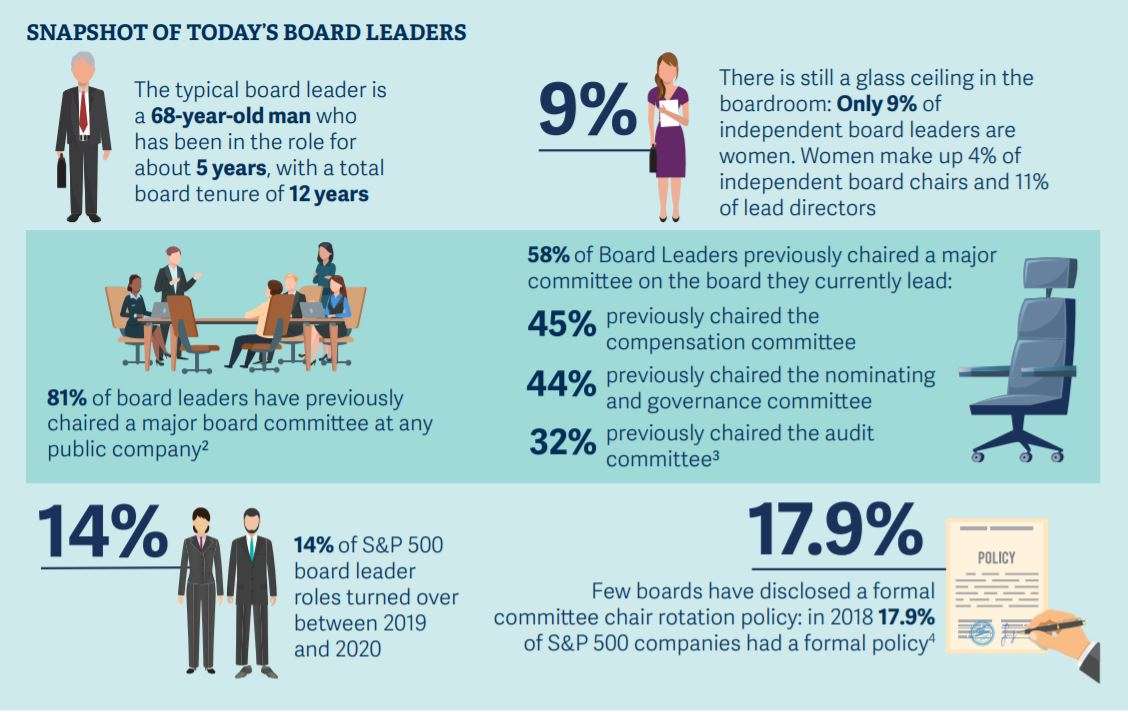Executive Summary: Rigorous board leadership succession plans can address the need for ongoing long-term processes and the need to respond to specific
The COVID-19 crisis has increased the demand for board support, oversight, and advice. It has also forced boards to adapt to new ways of working, including more frequent virtual meetings and increased communication with management. Many board leaders1 have stepped up as a powerful sounding board for stressed CEOs, while others have struggled, not contributing as needed or causing unnecessary distractions for overburdened boards and executive leaders. The very nature of the pandemic has heightened concerns about leadership succession and the risk of unplanned departures from the board.
During a period of uncertainty such as this, the board’s top leader exercises a level of responsibility that is critical for good governance and the effective functioning of the board. Yet, our research and our experience drawn from our advisory work indicate that many boards approach their own succession planning and leader selection efforts in a reactive, informal manner. While individual directors may have a sense of who might be a good candidate, boards overall often do not have a clearly defined succession planning process or any agreed-upon role criteria. This paper sets out to provide guidance for organizations without a clearly defined succession plan.
Today’s Independent Board Leaders
Below are some key statistics about independent board leaders in the S&P 500.

Today’s independent board leaders have extensive board and committee chair experience due to their long tenure. While this experience is beneficial, the length of their service and their inevitable transition out of those roles, means that many board leadership roles are likely to turn over in the next few years. Additionally, as expectations for board leaders continue to increase, some boards will commence a transition earlier than initially planned to appoint a new leader who is better suited to meet the evolving expectations of stakeholders.
In our experience, rigorous board leadership succession planning addresses both the need for an ongoing, long-term process as well as the need to respond to specific events that trigger a leadership change. We recommend a four-step process for boards:
Step One: Designating a Point Person and Timeline
The succession process should start well in advance of an expected board leadership transition. By starting early, boards can create experiences that are developmental and evaluative for several candidates.
The board should nominate a point person to lead the succession process—usually the most senior independent director who is not a candidate.
The senior director who is leading the process should develop the timeline for selection, creating a one-year timeline if there are internal candidates or a two-year timeline if there are not. The timeline should also account for any planned CEO succession to ensure the new board leader will be able to guide that process effectively and maintain a degree of board leadership continuity before and after the CEO succession.
Step Two: Role Criteria Development
Next, the senior director should engage the board in a discussion of the role criteria for the future board leader. In this discussion, the board will determine any changes in responsibilities or personal characteristics they would like to see in the next board leader. Taking into consideration the purpose of the company and the evolving business strategy.
Although the job description and responsibilities of a board leader varies from company to company, the expectations of the role often include frequent interaction with the CEO, setting the board agenda, orchestrating board interactions, driving board composition and quality, and representing the company to internal and external stakeholders.
Step Three: Assessment
After the criteria have been agreed upon by the board, the senior director will evaluate fellow directors by discussing with each director their perspectives on who meets the criteria and their personal interest in the role. The senior director should also consider each candidate’s complementary experience and relationship with the CEO.
As part of this dialogue, the senior director will identify the developmental opportunities for each potential board leader, including the option of rotating committee chairmanships. Committee chair rotation allows the board to test candidate readiness as well as identify potential candidates who can take over in an emergency succession. It is essential that the senior director proactively ensure that diverse board members are encouraged to put themselves forward and participate if the glass ceiling in the boardroom is ever to be shattered.
Based on this evaluation, the senior director will identify the leading candidates and report back to the board.
Board Leverages Outside Consultant for Board Leader Succession
An S&P 500 company faced both a planned CEO transition and the retirement of its lead director in the same timeframe. While the outgoing CEO had also been the board chair, working in tandem with the lead director, the company decided to move to a new model and appoint a non-executive director as an independent board chair.
The outgoing lead director and CEO directed the succession process since many of the other senior directors were candidates for the role. The board engaged Russell Reynolds to interview all directors and ask each one how the role should change, what qualities and character traits the new chair needs, and which current directors would be a good fit given their responses to the first two.
RRA collected the responses and put together a role specification for the next board leader. Three candidates emerged through this process with one director clearly standing out as the best choice. The outgoing lead director and the new chair overlapped for one board meeting. The board continues to regularly conduct an annual board evaluation and individual assessment of the chair. The other candidates remained engaged and continued to chair key board committees.
Step Four: Board Leader Selection
After the assessment phase is over, the senior director will propose the new board leader to the board in an executive session with the candidate(s) having recused themselves from that part of the meeting. The board may still have to choose between two or three qualified and interested candidates, though the intention would be to narrow the options through the assessment process. Once the appointment is agreed upon, the board may want to ratify this decision with the outcome recorded in meeting minutes. Care should be taken by the senior director to ensure any candidates not selected still have valuable roles on the board.
Ideally, there will be some overlap between the outgoing and incoming board leaders to ensure a smooth handover. Additionally, the incoming leader should spend additional time with the CEO to ensure an effective working relationship. While this is going on, the board should work with the general counsel to determine how they will communicate the leadership transition internally and externally.
In an emergency situation, the senior director will need to talk to the candidates who were in the ongoing development process to assess their availability to step into the role immediately. It may be the case that none of the preferred options are available, in which case the senior director may have to consider taking the role in the short term and initiating a new succession process.
Considering an Outside Candidate as the Next Board Leader
If none of a board’s current directors have enough experience, interest, or availability to become the board leader, the board needs to conduct an external search for a candidate who has the potential to join the board before becoming the leader 12-18 months later. The criteria developed for the role should be integrated into the search specification. The senior director should be clear with external candidates that they are being considered for a future board leadership role.
Once the board has appointed the new director, the senior director should consider moving him or her into a committee chair role as soon as is practical. This will expedite his or her learning about the company and the board and give directors the chance to assess whether the new director is equipped to lead the board.
Proactive is Effective
It is also worthwhile for boards to consider conducting an annual assessment of their new board leader as part of their board self-evaluation process. This assessment should be led by the nominating and governance committee chair or could be an additional responsibility given to the senior director identified to lead the succession process. The assessment should provide the board leader with useful developmental feedback.
With stakeholders expecting more of boards, it is important now, more than ever, to have a clear and rigorous leadership succession process to ensure a diverse pool of candidates and ultimately select the best leader possible.
Methodology
Based on an analysis of 466 organization’s board leaders’ prior board experience in the S&P 500 as of March 2020 with data obtained from BoardEx. This analysis is comprised of 434 unique individuals as some board leaders led more than one public board. To evaluate board leader turnover between 2019 and 2020, we used the 2019 S&P 500 list of companies, omitting any which were no longer publicly listed. In conducting the analysis, we use the term “same company” to refer to the company that the board leader leads. Since the 2019 analysis of board leaders’ experience, we expanded the definition of prior committee chair experience to include any chairmanship with a start date that predates their board leader role.
- Anthony Goodman is a senior member of Russell Reynolds Associates’ Board Effectiveness and Advisory practice. He is based in Boston.
- Alexander Madronal is a member of Russell Reynolds Associates’ Board and CEO Advisory Partners knowledge team. He is based in Boston.
1. We use the term board leader to describe the independent, non-executive board chair or lead independent director, sometimes also referred to as the presiding director.
2. We defined a major committee as the Audit, Compensation, or Nomination & Governance Committee.
3. Numbers do not add up to 100% as many board leaders had chaired more than one committee on the same board before becoming the board leader.
4. The Conference Board. “Corporate Board Practices in the Russell 3000 and S&P 500: 2019 Edition,” 2019.

 5.0
5.0 













